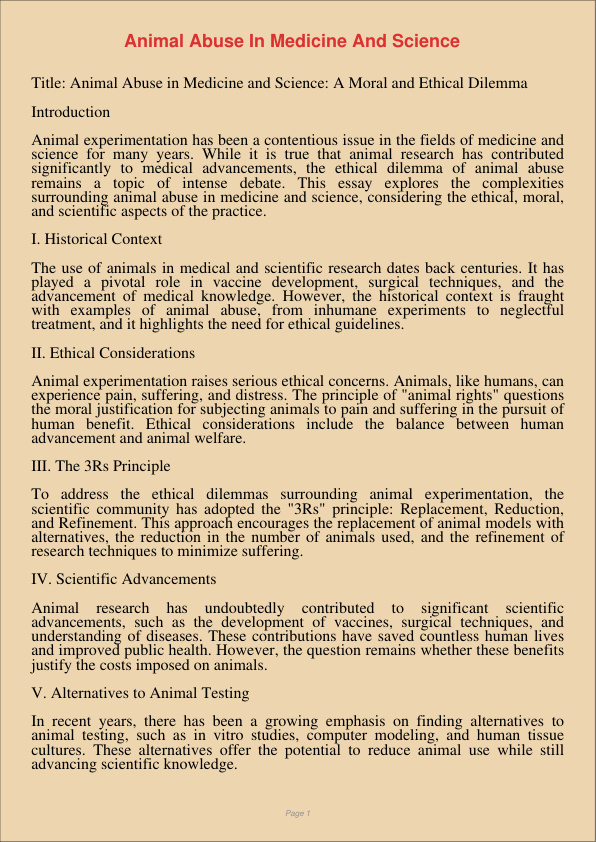Animal Abuse In Medicine And Science
Jan 12, 2024
animal abuse
science
Environmental Studies
Information Technology
Title: Animal Abuse in Medicine and Science: A Moral and Ethical Dilemma
Introduction
Animal experimentation has been a contentious issue in the fields of medicine and science for many years. While it is true that animal research has contributed significantly to medical advancements, the ethical dilemma of animal abuse remains a topic of intense debate. This essay explores the complexities surrounding animal abuse in medicine and science, considering the ethical, moral, and scientific aspects of the practice.
I. Historical Context
The use of animals in medical and scientific research dates back centuries. It has played a pivotal role in vaccine development, surgical techniques, and the advancement of medical knowledge. However, the historical context is fraught with examples of animal abuse, from inhumane experiments to neglectful treatment, and it highlights the need for ethical guidelines.
II. Ethical Considerations
Animal experimentation raises serious ethical concerns. Animals, like humans, can experience pain, suffering, and distress. The principle of “animal rights” questions the moral justification for subjecting animals to pain and suffering in the pursuit of human benefit. Ethical considerations include the balance between human advancement and animal welfare.
III. The 3Rs Principle
To address the ethical dilemmas surrounding animal experimentation, the scientific community has adopted the “3Rs” principle: Replacement, Reduction, and Refinement. This approach encourages the replacement of animal models with alternatives, the reduction in the number of animals used, and the refinement of research techniques to minimize suffering.
IV. Scientific Advancements
Animal research has undoubtedly contributed to significant scientific advancements, such as the development of vaccines, surgical techniques, and understanding of diseases. These contributions have saved countless human lives and improved public health. However, the question remains whether these benefits justify the costs imposed on animals.
V. Alternatives to Animal Testing
In recent years, there has been a growing emphasis on finding alternatives to animal testing, such as in vitro studies, computer modeling, and human tissue cultures. These alternatives offer the potential to reduce animal use while still advancing scientific knowledge.
VI. Legal and Regulatory Framework
Many countries have established legal and regulatory frameworks to govern the use of animals in research. These regulations are designed to ensure ethical treatment and minimize suffering, but enforcement can be inconsistent, leading to concerns about animal abuse.
VII. Ethical Research Practices
Promoting ethical research practices is essential to minimize animal abuse. Researchers should adhere to strict guidelines, ensuring that animals are treated with care and respect. Transparency in research, peer review, and ethical oversight committees play a critical role in ensuring compliance with ethical standards.
VIII. Public Awareness and Advocacy
Increasing public awareness about the ethical issues surrounding animal experimentation is crucial. Advocacy for the ethical treatment of animals in research, and funding for alternative methods, can drive change within the scientific community and in governmental policies.
Conclusion
Animal abuse in medicine and science is a complex moral and ethical dilemma. While animal research has undoubtedly contributed to significant scientific advancements, it raises serious concerns about the treatment and welfare of animals. The 3Rs principle, the development of alternatives to animal testing, legal regulations, and ethical research practices are steps in the right direction.
Balancing the pursuit of scientific knowledge with the ethical treatment of animals is an ongoing challenge. The scientific community, policymakers, and society at large must continue to engage in a constructive dialogue to find solutions that prioritize both scientific progress and the ethical treatment of animals, ultimately striving for a world where animal abuse in medicine and science is minimized and, wherever possible, eliminated.
